What are TAR? How do they origin?
Discover more about this condensable species that are produced through combustion, gasification and pyrolysis of hydrocarbon-based fuels.
The goal of this article is to provide you information on the TAR, known also as condensable species that are produced in the treatment process (combustion, gasification, pyrolysis) of hydrocarbon-based fuels. In particular, the article is structured in three different areas:
- Introduction to the combustion reactions. What are the main parameters that govern combustion reactions? Why can be formed pollutant species such as TAR? What are the TAR specifically?
- Phases of the combustion of a solid matrix. What are the different chemical-physical phenomena that characterize the combustion of a solid matrix? At what stage are TAR produced?
- Harmful effects of the TAR. Why the TAR are dangerous? What are possible consequences may have if inhaled?
Introduction to reactions of burning
Among all the discoveries made by man, probably one of the most significant is that of fire. The fire has allowed our ancestors to cook food, to extend their activities until late, to protect themselves from predators and to warm up in the freezing winter nights.
Today, as then, the combustion processes are essential. It is thanks to these processes that we see a cheery fire in the fireplace, we can move in the car and we can produce electricity in large power plants.
In the branch of production of electricity, a lot have done (and still do) fossil fuels. Alongside the fossil fuels are increasing the importance the renewable sources, always used and now more important to meet global energy needs reducing environmental impact of pollution.
In particular, are emerging increasingly efficient technologies for the treatment of biomass. When it comes to combustion or gasification of biomass (or other solid fuels), the efficiency is crucial. Indeed the reactions which take place are extremely complex, and can provide as output a series of chemical species that do not represent the typical products of partial or total combustion (CO, H2, CO2, H2O). A careful control of the operating parameters allows to considerably increase the efficiency of the system, in terms of energy performance and in terms of production of polluting species.
What are these “operating parameters”? An important parameter, which has important implications in the formation of pollutants, is the fuel / air ratio.

To analyze the impact of this important parameter, temporarily withdraw ourselves from the world of solid fuels and consider the simplest hydrocarbon species: methane. The methane, to give a complete combustion reaction, needs a well-defined amount of oxygen. In particular, two oxygen molecules for each molecule of methane will become necessary.
This defined proportion between quantity of methane burned and oxygen required is defined stoichiometric ratio of the complete combustion reaction.

The combustion reactions do not always occur at stoichiometric conditions: there may be an excess or a lack of air. To make a quantitative estimate of the combustion conditions it was introduced a parameter, which is called the equivalent ratio which is defined as follows.
Based on the operating conditions, we can distinguish three different regimes:
- Φ <1: If the equivalent ratio is less than the unit value it means that you are in the excess air conditions. The excess-air conditions allow to carry out the complete combustion reactions (as oxygen is over stoichiometric value), but may lead to a lowering of the combustion temperature. In fact the additional combustion, which does not participate directly in the combustion reaction, acts as a thermal flywheel and absorbs some of the heat given off the hentalpy of the oxidative process.
- Φ = 1: In this case the ratio between fuel and air meets the stoichiometry, thus the amount of oxygen present is that required for the total combustion of the hydrocarbon.
- Φ> 1: In these conditions there is an excess of fuel. The amount of this air is not sufficient to allow for complete combustion of the hydrocarbon matrix, and it will therefore have a partial combustion. When the parameter values are significantly greater than the unit value, there is a predominant presence of the fuel, which in the absence of air may thermally decompose to the effect of pyrolysis processes.
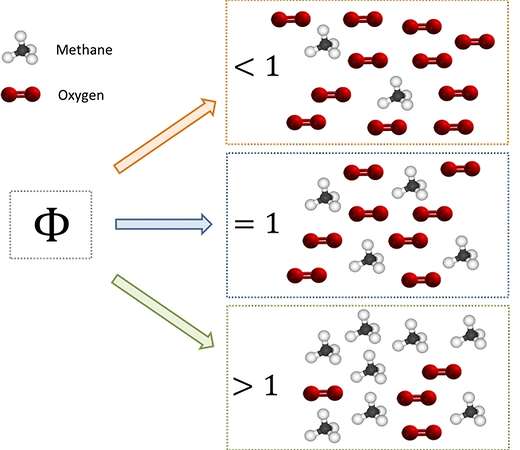
Now that we have defined the various possible operating conditions, it is imperative to make a clarification. If, for example, we feed a quantity of air corresponding to the stoichiometric one (Φ = 1), it is said that throughout the volume in which the combustion reaction occurs the fuel / air ratio is equal to the stoichiometric ratio. in fact there can be some areas with excess of fuel (Φ> 1) and areas with a shortage of fuel (Φ <1), on the basis of the mixing phenomena. Here is a basic condition: the proper mixing of fuel and combustion. The chemical aspect of combustion reactions is only one side of the coin: the other side corresponds to the complicated transport phenomena that occur.
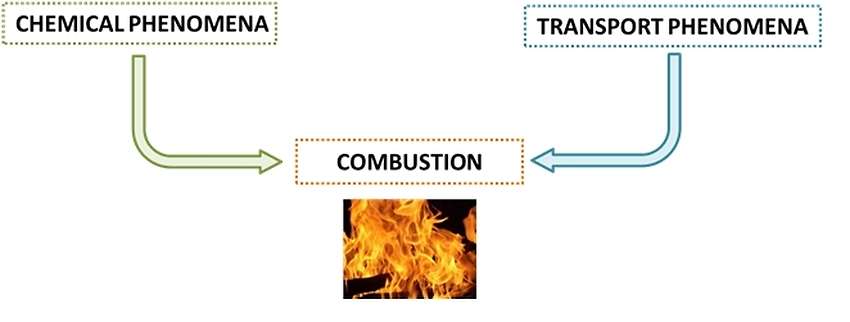
On the basis of the temperature levels and local composition, they may in fact be formed polluting species. Let us examine this aspect taking into account the same molecule before (methane), and examining the complex nature of radicalic reactions that characterize its combustion process.
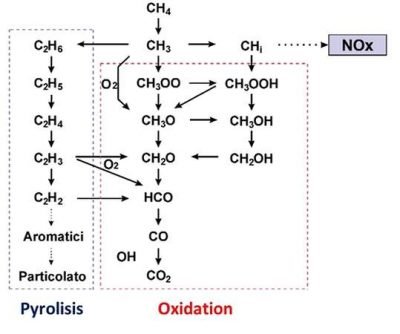
As we can see in the picture, the methane combustion mechanism involves a multitude of chemical species. In particular, we can see how the presence of oxygen leads to oxidation of the hydrocarbon species, while its absence leads to a pyrolytic nature mechanism. In the nature of the pyrolytic process we can notice that the reaction of two methyl radicals (CH3) leads to the formation of ethane (C2H6), which for subsequent reactions of de-hydrogenation form ethene (C2H4) and finally the acetylene (C2H2). The latter species contains a triple bond between the two carbon atoms, and behaves as a precursor of aromatic species (benzene and PAH – Polyaromatic Hydrocarbons).
It is in this process that takes the potential formation of the TAR. This term is to indicate broad classes of compounds, liquefiable and predominantly hydrocarbon, which develop in consequence to pyrolytic processes at high temperature.
We noted the complexity of the kinetic mechanisms of methane combustion / pyrolysis. Imagine how this complexity further increases when we consider the burning of hydrocarbon species less simple! If we consider the combustion of solid species (such as biomass) or liquid, the description of the combustion process is further makes more intricate because of the inter-phase transport mechanisms. In fact the non-efficiency of these processes can lead to the genesis of pyrolysis zones, resulting TAR formation and soot (particulates).
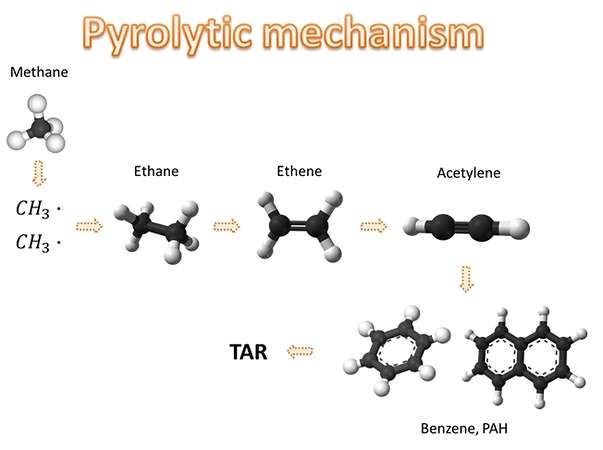
Mechanism of a biomass burning
A solid biomass can be described on the basis of three main components:
- Cellulose: is a structural component of fundamental importance in cell walls of plants. It results to be a polymer chain that includes up to 10000 units of D-glucose molecules.
- hemicellulose is a complex mixture of different sugars (xylose, mannose, galactose and arabinose), of which xylose is typically the most abundant.
- Lignin is a complex macromolecule, with very high molecular mass. It tends to confer mechanical strength to the plant.
To understand how it behaves in a biomass pyrolysis conditions, you can analyze how behaves each of its members under the same conditions. This analysis may be performed experimentally, and takes the name of thermo-gravimetric analysis. Imposing a certain rate of warming of the material, simply register varies the mass variation over time of the material in question. As the temperature increases, it can be noted how the mass of the solid matrix decreases, and instead tend to form liquid and gas substances, and in consequence to the depolymerization of the chains which characterize the species before described. It is precisely at this stage that there is the formation of the TAR, liquefiable species coming from the pyrolysis of the solid matrix.
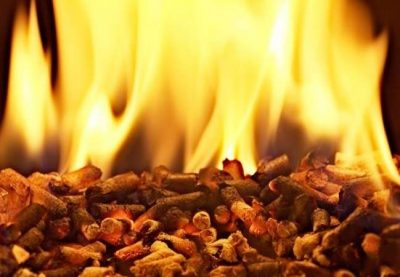
Looking in more detail, the combustion of a solid matrix, one can recognize the following steps:
- Dehydration: when the heat comes to the particle, this begins to increase its temperature. In consequently, to heat the water present in the solid matrix tends to transire in the vapor phase, and there is a consequent reduction in humidity of the particle itself.
- devolatilizing and pyrolytic processes: as a consequence of the continuous increase in temperature, the more volatile molecules that characterize the solid matrix tend to pass into the vapor phase. It is both simple hydrocarbon species that more complex species (PAH), some of which distinguish precisely the TAR. In the vapor phase of the secondary pyrolytic phenomena occur, which tend to further modify the nature of the described molecules.
- combustion in the gas phase: if it has adequate mixing between fuel and oxidizing agent, the species present in the gaseous phase meet the oxygen and give rise to oxidation processes (which heat the other particles, present and future are the phenomena first described) . Without adequate mixing can be of the zones in the hydrocarbon predominating, in which the combustion reactions do not take place. The lack of combustion may lead to the hydrocarbon species stay the same. These may give rise to the formation of soot, which we will cover in another article.
- combustion of the char residue: as a result the devolatilization, the mass of the solid matrix decreases and tends to remain a solid carbonaceous nature, referred to as char. An effective contact between air and char allows further oxidation of the latter: the end of this process remain the ash, which can not burn.
- Discharge of ashes: the remaining ashes are discharged from the boiler or from the reactor, to allow the introduction of new material.Well, we saw the combustion stages comprising the formation of PAH and the TAR. The question we now ask is: what effects these compounds have on human health?
Effects of TAR on human health
Quantify the effects of the TAR on human health is complex. One factor contributing to the complexity is definitely the high number of species that characterize the TAR: while some may be harmless, others can be potentially dangerous.
Benzene, for example, is carcinogenic for both men and animals. Other compounds that characterize the PAH, instead, have mutagenic action. For example benzo (a) pyrene, by action of cytochrome P-450, is epoxidized: then through subsequent reactions form a species that can react with DNA, introducing the mutations.
The question therefore arises spontaneously: it is possible to intervene to remove the tar from the process streams?
An answer to this question lies surely in a preventive action, which is to make an optimal design of boilers and reactors; This allows you to promote effective mixing between fuel and oxidizing.
There are also post-treatment methods, which we will analyze in a later article!
Awaiting further information, visit our product and our Case History!
See you soon!
Bibliography
[1] A. D’Alessio, A. D’Anna, T. Faravelli e E. Ranzi, «Particolato fine e ultrafine,» Chimica & Ambiente, pp. 34-42, 2005.